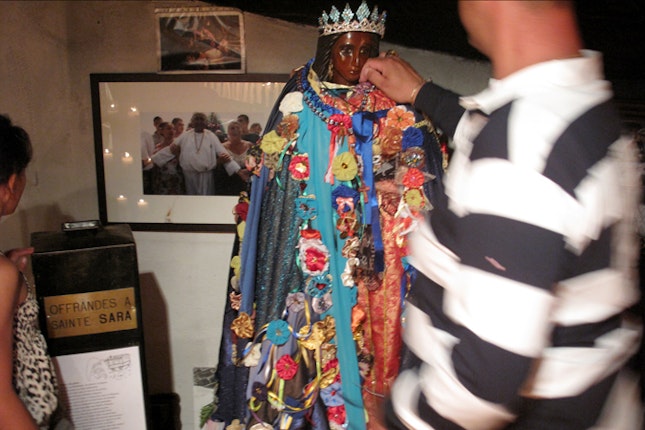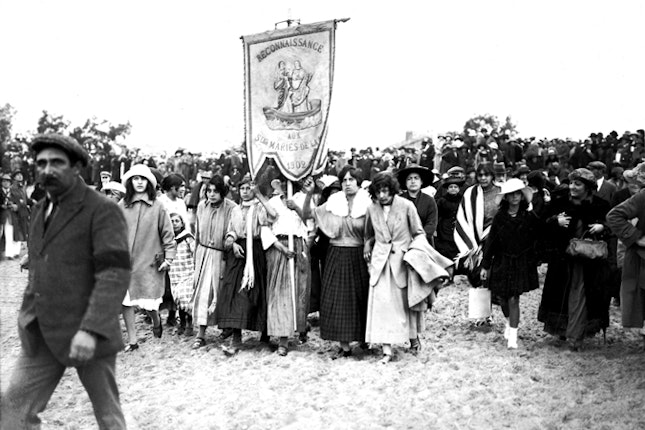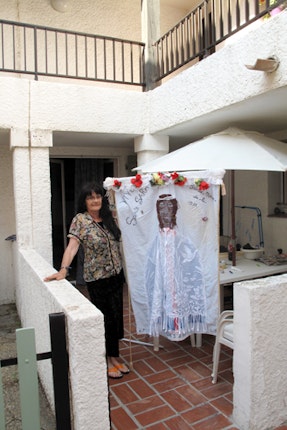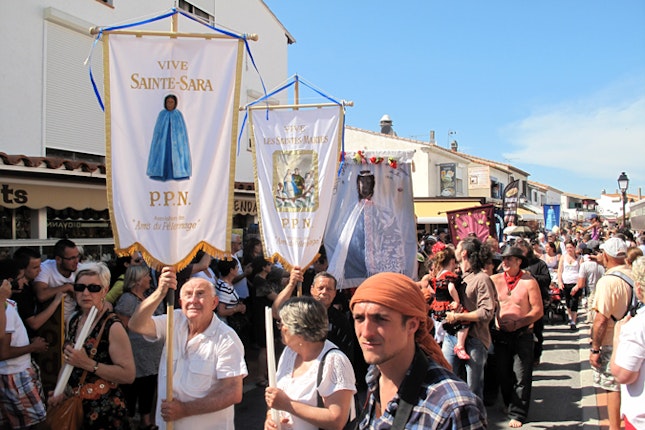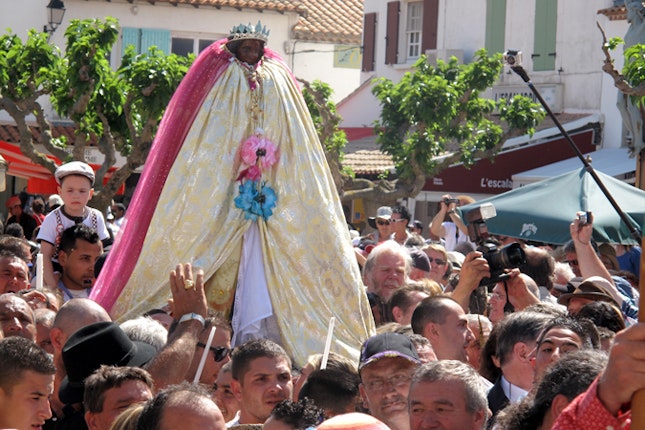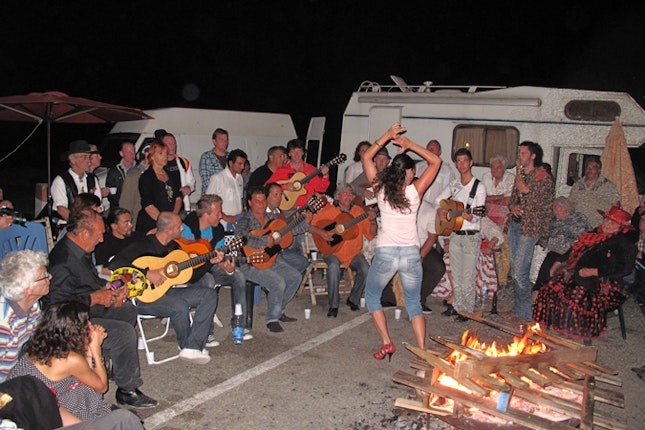Roma in Political Life: France—Gens du Voyage and the Roma of France
By Chuck Sudetic
Itinerant citizens of France—people who inhabit campers, house trailers, or horse-drawn wagons—have for over a century been required to comply with laws that do not apply to people who reside in houses, apartments, or other fixed domiciles. Most of these itinerants—French law terms them gens du voyage—belong to relatively small ethnic groups that are today considered components of Europe’s Roma.
The Roma of France include groups of people who call themselves Gitanes, Kale, Manouches, Roma, Sinti, Tsiganes, Yenisch, and other names. Many prefer not to identify themselves collectively as Roma. The government of France does not officially recognize any minority groups among its 65.4 million citizens, so there exists no official breakdown of these Roma subgroups. Rough estimates of their total numbers range from 300,000 to 500,000.
During the Sarkozy ascendancy, government officials and members of the public engaged in “Gypsy-bashing” for political effect, targeting the Roma who migrated to France from Romania and other countries. These attacks motivated groups of Roma native to France to organize themselves and to demand equal treatment under the law.
The Council of Europe’s European Committee for Social Rights found in 2009 that France’s laws and regulations affecting gens du voyage violated the Revised European Social Charter. In 2010, the Committee found that French laws governing identification documents and voting rights for gens du voyage also violated the Social Charter.
France’s antidiscrimination authority and its national human rights institution called for reform of the same laws. Efforts by advocates bore fruit in October 2012, when France’s equivalent of a constitutional court struck down parts of a 1969 statute that had governed identification documents and voting rights.
Internal Travel Documents
All citizens and residents of France must carry national identification cards. From 1912 to 1969, however, France also required all gens du voyage 16 years of age and older to carry a special “carte anthropométrique” travel document, which, in addition to fingerprints and two photographs of the card holder, detailed the holder’s physical features. The “carte anthropométrique” document was superseded in 1969.
Gens du voyage 16 years of age and older with a regular income now had to possess a new internal travel document, le livret de circulation, and have the police stamp it every year. Those with no regular income had to carry a different travel document, le carnet de circulation, which the police had to stamp every three months. Any itinerant person who failed to obtain one of these internal travel documents and the required stamps risked a fine and a jail term.
It took until October 2012 for France’s constitutional council to strike down provisions of the 1969 law relating to the carnet de circulation. Subsequently, all gens du voyage over the age of 16 were required to carry a livret de circulation.
Voting Rights
The October 2012 ruling also struck down a provision of the 1969 law that had enabled gens du voyage to exercise their right to vote only after they had been registered in a particular municipality for three years. Any sedentary citizens moving into a new municipality could vote after six months. The 2012 constitutional council ruling applied the six-month residency requirement to all persons carrying the livret de circulation.
The ruling left untouched, however, a provision of the 1969 law that, in most instances, limits the number of gens du voyage in a given municipality to 3 percent of the local population. This prevents them from acquiring political leverage at local levels of government.
Housing
French law requires each of the country’s municipalities with a population greater than 5,000 to provide gens du voyage with stopover areas that have access to drinking water, sanitary facilities, and electricity. In 2011, 48 percent of the affected municipalities had established a total of 16,000 camping spaces, but there remained a shortfall estimated at 20,000 by the government and 60,000 by nongovernmental organizations. This shortfall forces many gens du voyage to camp illegally.
Many campsites are located far from retail stores, schools, and residential neighborhoods, but close to waste treatment plants, electricity transformers and high voltage lines, heavily trafficked roads, and brownfield sites. Some gens du voyage and some sedentary Roma who reside on land they own have not been provided with hookups to water, electricity, and sewage services. Gens du voyage often encounter resistance if they seek to purchase real property.
Education
A significant number of gens du voyage do not enroll their children in school, which violates French law. Many gens du voyage children who are enrolled miss classes for much of the school year. Many transfer schools frequently, which interrupts their instruction.
Since the French government limits the period gens du voyage can stop in designated camp sites, parents have difficulty keeping their children in a single school for an entire school year. School administrators in some municipalities have refused to enroll gens du voyage children, even if their families reside on private land for significant periods.
Roma Voices in Saintes-Maries-de-la-Mer
According to legend, years after the crucifixion of Christ, his companion Mary Magdalene journeyed with two other women also named Mary from the Holy Land to a seaside village that is now the town of Saintes-Maries-de-la-Mer in France. During a stopover in Egypt, a dark-skinned woman named Sara joined the voyagers. Catholic Roma claim this Kali Sara—kali means “black”—as one of their own and venerate her as a saint.
Over the years Roma pilgrims began to converge on Saints-Maries-de-la-Mer to pray before a statue of Kali Sara in the crypt of the local church. They were barred from entering the sanctuary. In 1935, a respected civic leader, the Marquis Folco de Baroncelli, convinced a Catholic archbishop to permit the Roma to convey the statue in a procession to the sea each May 24. This ritual is now the centerpiece of an annual Roma family homecoming, a world-famous festival of costume, dance, and flamenco and Manouche music, and an informal convocation of Roma leaders.
Payou Baptiste is the public face of a Gitane clan whose men carry the statue of Kali Sara into the sea. “Marquis Baroncelli was so important for us,” said Baptiste, who lives in the town of Ales and works as a mediator between his community and government institutions. “Baroncelli was the first person to speak up for us.”
Officials in France have long used intermediaries such as Baroncelli and clan leaders such as Payou Baptiste to speak on behalf of the Roma rather than include a broader sweep of Roma in decision-making, a political reality Roma advocates are working to change.
“Gens du voyage are constantly searching for places to camp, and many stopover areas are closed to them. So they end up in shitty places, near dumps and train tracks,” said Baptiste. “There are areas near Arles where gens du voyage have been stopping for many years. Now the prefecture wants to move them out for ‘development.’
“The police regard us as bad boys,” Baptiste said. “Even here in Saintes-Maries there are too many police. This is a religious procession. But the police see it as a demonstration. We’re not going to steal the beach. And we are afraid that the attacks on Roma migrating from Eastern Europe will broaden into attacks on gens du voyage, French citizens.”
Also afraid for her people is Sylvie Zigler, a well-known musician—her stage name is Negrita—who is half-Roma, half-Manouche, and one of the gens du voyage. She has used her celebrity to advocate for Roma rights.
Born in a horse cart, Negrita learned to play guitar and sing when it was taboo for Roma girls and women to do so. She never learned to read or write; neither did her two daughters, now mothers in their twenties. Negrita today travels in a camper from venue to venue with members of her family. “An apartment would be a prison for me,” she said.
“I first made money as a singer when I was eighteen,” Negrita said. “I scrawled my name on my first record contract, and others followed. I kept getting ripped off, because I can’t read. My two girls were placed in the back of a classroom. The teacher didn’t like them. They said we were dirty.
“We have never had problems here in Saintes-Maries-de-la-Mer like those we’ve experienced in the past five years,” she said. “I go right to the mayor to complain. I’m not afraid. I go there with a TV crew. I’ve threatened to block roads.”
“All of our communities must struggle now for their rights,” she said. “We have many problems: electricity, water, gendarmes.”
On May 22, 2008, a gendarme at a military police station in the town of Draguignan shot the 26-year-old son of Negrita’s friend Micheline Guerdner, another of the gens du voyage. Her son had gone to the police station to have the three-month stamp affixed to his internal travel document. Press reports said the police questioned him about a crime and about a loaded handgun they had discovered in his car.
Seven bullets struck Guerdner’s son, four of them in his back. According to police, during a cigarette break in the interrogation, he had leapt through a window and attempted to escape. He was wearing cuffs on his arms and on one of his legs. A military judge ruled the shooting justifiable.
The ruling scandalized Europe. Negrita performed to a packed house in Italy to raise money for legal fees. In January 2012, the European Court of Human Rights announced that it had decided to take up Guerdner’s case.
Another Roma activist, Esméralda Romanez, has waged a lonely struggle to organize the Gitanes, Kale, Manouches, Roma, Sinti, Tsiganes, and Yenisch to pay homage to their dead. The French government began rounding up Roma before Nazi Germany invaded the country in 1940. During the war, the authorities continued to run internment camps in both occupied and unoccupied regions of France. Some Roma were sent to work in extermination camps.
Members of the Baptiste family perished. Negrita’s father was held in Auschwitz and Buchenwald before escaping. Romanez’s father was seized, tattooed with a number, and dispatched to Dachau before ending up in a camp in Austria where prisoners were starved, forced to work, shot, and beaten to death arbitrarily.
“When I was still a kid, my father told me how he had run for his life after the prisoners were lined up next to a pit to be shot,” Romanez said. He was a Manouche basketmaker and violinist married to a Gitane woman, who had also been confined in a wartime camp. Romanez and her family lived for decades in a wagon before she suffered a stroke. Afterward, she established a small organization to press the government to do more to commemorate Roma victims of the wartime detention and death camps.
Each May 21, Romanez helps organize a commemoration at the site of a wartime internment camp about 50 miles from Saintes-Maries-de-la-Mer. On May 24, she carries the banner of her organization in the Kali Sara procession.
The authorities in Saintes-Maries-de-la-Mer give the Roma until May 26 to vacate camping areas around the town. If they linger, front-end loaders position concrete blocks to close off camping areas and parking lots. Anyone whose camper is caught inside is forced to pay a fine.
The town’s mayor once said the Roma were free to move their festival to Lourdes.
This article is part of a series examining Roma political participation in France, Hungary, Romania, Macedonia, Bulgaria, and the Czech Republic.
Until November 2013, Chuck Sudetic was a senior writer for the Open Society Foundations.
